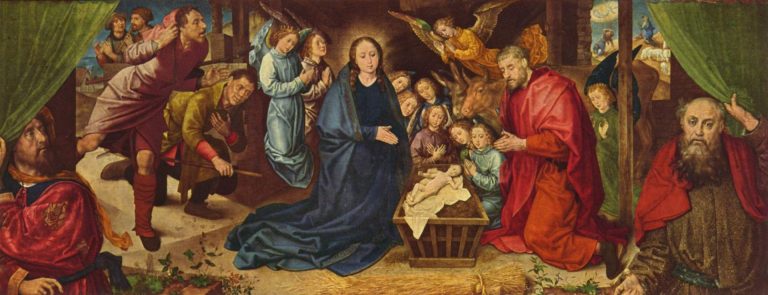By Scott Hahn

As the first family and the first church of the New Covenant, the Holy Family isn’t just the model family community, but the model ecclesial community. Mary and Joseph show us what and who we can be when we unite ourselves to Christ.
There has never been and never will be a more perfect marriage or a more perfect church than the Nazarene trinity we call the Holy Family. Mary and Joseph were in constant contact with the Son of God; every interaction with Jesus was a kind of prayer. They submitted themselves to His divine will, while He humbly submitted Himself to their earthly authority in “the temporal image of his filial obedience to his Father in heaven” (CCC 532).
What an incredible responsibility—to have parental authority over the Son of God! While we must imagine this duty weighed on Jesus’ mother and foster father, we also have every reason to believe they wore it lightly. After all, both (Mary especially) were imbued with tremendous grace at the Annunciation of Christ’s coming, and then continually henceforth as they spent their lives in the physical, human presence of God.
But they still had to cooperate with this outpouring of grace. Like all of us, Jesus’ family had free will. Despite Mary’s Immaculate Conception, she didn’t have to give her fiat to God through the angel Gabriel. Joseph didn’t have to take on the potential scandal of wedding a pregnant virgin (who would believe that story?). They didn’t have to stay on the path to Calvary when Simeon spoke to Mary during the presentation of Jesus in the temple, saying “a sword will pierce through your own soul” (Lk 2:35). And yet, every day for more than thirty years, they pressed forward to a culmination they knew would be painful, but not yet how painful. The thought might come to mind, “If I saw and spoke with Jesus every day in my home, it’d be easy to be good! Mary and Joseph had the ultimate advantage in the quest for holiness.” But that’s just the thing: we do have the advantage of the presence of the Lord. We can appeal to Him every day, several times a day, just like His earthly parents could. We can make Him the centerpiece of family life. We can even, incredibly and beautifully, encounter His tangible and complete presence in the Eucharist, both in Communion and in adoration.
This takes some imagination, but more than that it takes trust—trust that He is there and that He is listening even when we can neither see nor hear Him. Again the Holy Family stands out as a model. Mary and Joseph had to trust Him too, even when it was nearly impossible to do so. They had to trust that His teenage excursion to the temple was God’s will, not precocious rebellion. They had to trust that His departure for public ministry was not a rejection of their three decades of family life. And, most powerfully, they had to trust that His delivering Himself into the clutches of His bloodthirsty enemies would somehow be for the best.
We should not look at the Holy Family as some ethereal, unattainable goal, but as an example of what is truly possible when we make Jesus Christ the center of our lives. After all, this is the essence of the New Covenant: the extension of family ties with the Lord to all the world. The Holy Family shows us what that means. It’s up to us to follow through.
Dr. Scott Hahn is president of the St. Paul Center and author of over forty books on theology and biblical studies. His book The First Society: The Sacrament of Matrimony and the Restoration of the Social Order explores how reclaiming marriage as the fundamental unit of society can reorder culture to truth and goodness.